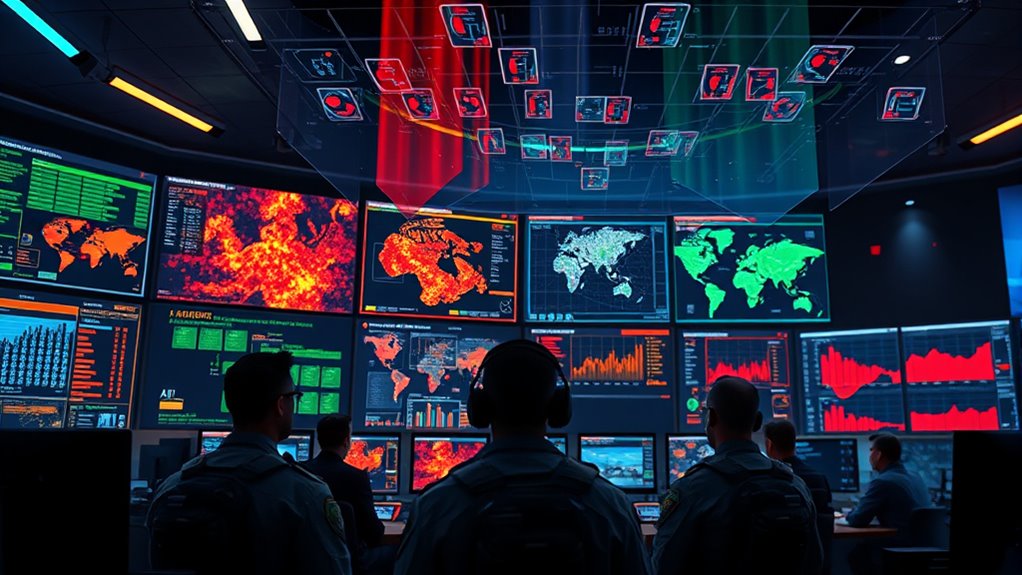AI and machine learning are transforming defense by detecting subtle anomalies that humans often miss. These systems process vast amounts of data in real time, identifying irregular patterns and emerging threats quickly. They adapt to changing environments, reducing false alarms and improving security. Unlike humans, AI works nonstop, analyzing signals from sensors, satellites, and drones. To discover how this technology is reshaping security measures, keep exploring the evolving capabilities of AI in defense systems.
Key Takeaways
- Machine learning analyzes large, complex data streams in real-time to identify subtle irregularities humans may overlook.
- It dynamically adapts detection models to evolving threats, maintaining high accuracy without constant updates.
- AI detects anomalies by recognizing patterns deviating from normal behavior, signaling potential security breaches or operational issues.
- Automated systems provide immediate alerts and responses, reducing human reaction time and increasing threat containment efficacy.
- Continuous learning enables AI to improve detection precision over time, uncovering concealed or emerging threats more effectively than humans.
The Role of AI in Modern Defense Strategies

Artificial Intelligence has become a cornerstone of modern defense strategies, transforming how militaries operate and make decisions. You benefit from AI-powered solutions that analyze real-time data and create predictive models, enabling autonomous decision-making on the battlefield. Autonomous systems like drones and robotic platforms now conduct surveillance and precision strikes, reducing risk to personnel. Dual-use technologies, applicable in both civilian and military fields, expand innovation, as seen in Japan’s startup ecosystem. The U.S. Department of Defense’s significant funding—$1.8 billion for FY2025—reflects AI’s strategic importance. Partnerships with leading AI companies help leverage cutting-edge capabilities for national security, giving you a technological edge. These advancements improve situational awareness, cybersecurity, and strategic planning, ensuring your military remains adaptable and competitive. The integration of home theatre projectors and other advanced display technologies contributes to enhanced training simulations and real-time battlefield visualization, further strengthening defense capabilities.
How Machine Learning Enhances Anomaly Detection Capabilities

Machine learning boosts anomaly detection by analyzing vast data streams in real-time, helping you spot irregularities quickly. Its pattern recognition adapts to changing environments, improving accuracy without constant updates. This allows your defense systems to identify subtle threats and respond faster, enhancing overall security. Fundamentally, anomaly detection is crucial for uncovering critical but hard-to-identify anomalies, serving as a vital tool in security and operational monitoring. Incorporating AI Security Technologies such as behavioral analytics further refines threat detection capabilities, making security systems more resilient.
Real-Time Threat Identification
Have you ever wondered how cybersecurity systems detect threats almost instantaneously? Machine learning makes this possible by analyzing massive datasets in real time. You benefit from algorithms that use supervised and unsupervised learning to spot anomalies quickly and accurately. These systems continuously adapt, refining detection as new threats emerge, ensuring you’re protected against evolving attacks. The speed of response is vital in today’s cyber landscape, allowing rapid identification and mitigation of threats. Plus, AI reduces False positives, distinguishing harmful activities from benign ones, so your team can focus on genuine issues. For example, Floating on Water principles can inform the development of resilient systems by emphasizing stability and adaptability under changing conditions.
Pattern Recognition Efficiency
The speed at which algorithms analyze vast amounts of data gives military and cybersecurity systems a significant advantage in detecting anomalies. You can process massive data streams—sensor feeds, satellite images, communications—in seconds or minutes, enabling rapid responses. Machine learning models, particularly deep learning, identify subtle and complex patterns that humans or rule-based systems often miss, reducing false positives. They synthesize data from multiple sources like radar, imagery, and social media to create a thorough situational picture. This multimodal integration uncovers hidden correlations and detects sophisticated threats like spoofing or infiltration. Additionally, these systems scale effortlessly across diverse environments, from urban centers to remote borders. Automated, real-time analysis ensures you stay ahead of emerging threats with unmatched precision and speed. AI-driven data fusion significantly enhances anomaly detection by integrating diverse datasets into a cohesive operational picture.
Adaptive Learning Systems
Building on pattern recognition capabilities, adaptive learning systems continuously refine their models to keep pace with evolving threats. You benefit from real-time updates that allow anomaly detection systems to adapt quickly without full retraining. These systems utilize online learning techniques to adjust to shifting behaviors and emerging threats dynamically. Graph Neural Networks (GNNs) enable models to evolve knowledge graphs, learning new patterns locally—perfect for edge deployment. Rebalance Stream algorithms enhance robustness by managing data variability and multiple anomalies simultaneously. Additionally, continuous updates help reduce False positives by refining detection boundaries based on recent data. Data adaptability ensures that detection systems remain effective even as threat landscapes change rapidly.
Differentiating Between Human and Machine Detection Methods

You need to understand how human and machine detection methods differ in precision, speed, and scope. Machines excel at processing large datasets quickly and consistently, while humans are better at recognizing nuanced or complex anomalies. Recognizing these differences helps you leverage each approach effectively in defense systems. AI-powered detection systems can operate continuously without fatigue, enhancing their reliability over long periods. Additionally, understanding cognitive biases inherent in human analysis can improve the integration of human judgment with machine outputs.
Human vs. Machine Precision
Human and machine detection methods each bring unique strengths and limitations to anomaly identification. Humans excel at understanding context and interpreting ambiguous signals but can miss subtle or complex patterns. Machines analyze vast datasets rapidly, identifying both obvious and hidden anomalies through pattern recognition. They can detect multivariate relationships and latent features beyond human perception, especially with deep learning. However, machines aren’t immune to false positives and require human oversight to refine their accuracy. Advances in machine learning continue to improve detection capabilities, making it essential to integrate both approaches for optimal results.
- Humans rely on intuition but struggle with high-dimensional data.
- Machines process large volumes at scale, reducing oversight gaps.
- Human errors stem from fatigue and bias.
- Machines continuously learn and adapt faster to evolving threats.
Detection Speed and Scope
Machines detect anomalies at lightning-fast speeds, analyzing massive datasets in milliseconds and providing real-time alerts, whereas humans take hours or days to review similar volumes of data. AI systems process and interpret continuous data streams instantly, enabling immediate identification of deviations. Automated alerts trigger responses within seconds, reducing potential damage. Unlike humans, AI operates 24/7 without fatigue, maintaining rapid detection. It ingests data from network traffic, system logs, user behaviors, and external feeds simultaneously, covering vast scopes that are unmanageable manually. Machine learning models adapt and refine their detection rules as they encounter new threats, staying ahead of evolving attack methods. In contrast, human analysts focus on limited data subsets, making detection slower and less exhaustive. This speed and scope give AI a decisive advantage in threat detection and response. AI’s ability to learn and improve over time ensures that detection capabilities become more precise and comprehensive with continuous operation. Additionally, automated analysis allows for the handling of increasingly complex and voluminous data, further enhancing detection efficiency.
Real-Time Data Processing and Its Impact on Security Response

Real-time data processing transforms security responses by enabling rapid detection and immediate action on emerging threats. It allows you to analyze continuous streams of data from sources like satellites, drones, and ground sensors instantly. Edge computing reduces latency by processing data locally, critical in battlefield environments with limited connectivity. Systems such as the TS640 integrate real-time analysis of electronic warfare, ISR, and EO/IR data, boosting operational awareness. Encrypted transmission protects sensitive information from cyber threats, ensuring compliance with defense standards. AI applications on local hardware deliver fast, scalable insights, improving decision speed and resource allocation. Enhanced decision-making is supported by automation’s role in synthesizing complex data sets quickly and accurately.
Advancements in AI-Driven Surveillance Technologies

Advancements in AI-driven surveillance technologies are transforming the way military operations gather and interpret intelligence. AI-powered drones like Lockheed Martin’s Astris AI improve surveillance and precision strikes, while deep sensing systems such as HADES and TITAN process vast battlefield data for better situational awareness. Autonomous systems, including unmanned vehicles, perform intelligence tasks with minimal human input, enabling faster response times. AI enables real-time analysis of satellite and sensor data, creating a thorough picture of threats. Machine learning algorithms predict potential dangers and continuously improve anomaly detection. Collaboration with civilian sectors accelerates innovation, making dual-use technologies adaptable and cost-effective. These advancements enhance surveillance capabilities, increase operational efficiency, and reduce risks in complex, dynamic combat environments. Deep sensing is an emerging buzzword linked to military technology marketing that emphasizes creating “transparent battlefields” and extending battlefield awareness beyond traditional limits. Additionally, understanding IRA investing strategies can help military organizations plan for long-term technology funding and resource allocation, ensuring sustained innovation in surveillance systems.
Case Studies: Successful Anomaly Identification in Military Operations

The success of military operations increasingly depends on AI’s ability to identify anomalies that signal threats or vulnerabilities. You’ve seen how AI has made a real difference across various missions. For example:
- Raven Sentry predicted insurgent attacks in Afghanistan, leveraging unclassified data to warn coalition forces.
- Operation Glowing Symphony disrupted ISIS’s digital infrastructure by combining cyber and information operations.
- DroneCrypt IFF detects anomalies in drone transactions within milliseconds, providing rapid threat identification.
- Data poisoning techniques can covertly compromise enemy AI, offering strategic advantages and legal avenues under U.S. law. Juice cleansing benefits and methods can inform the development of resilient AI systems by understanding how to prevent or detect data manipulation.
AI systems require continuous data curation and model tuning to maintain detection accuracy over time. These case studies showcase how AI’s anomaly detection capabilities help you identify hidden threats, improve operational efficiency, and gain a strategic edge in complex environments.
Challenges and Limitations of AI in Detecting Threats

While AI has demonstrated impressive success in identifying anomalies during military operations, it faces significant hurdles that can limit its effectiveness. Data labeling and imbalance challenges are major issues; anomalies are rare, making it hard to gather enough labeled examples for training. This limits supervised learning, while unsupervised and semi-supervised methods may reduce detection precision. False positives also pose problems, causing alert fatigue and desensitizing analysts. Balancing sensitivity with accuracy remains tough, especially in complex environments with fluctuating behaviors. Scalability is another concern—processing massive data streams in real time demands significant resources and optimized algorithms. Ultimately, models often act as “black boxes,” hindering trust and interpretability, while adversarial attacks threaten to bypass detection altogether. These challenges underscore AI’s current limitations in threat detection. Additionally, the rapid growth of AI market size and increasing data sources in defense make scalability and robustness even more critical.
Ethical and Regulatory Considerations in Autonomous Anomaly Detection

Ethical and regulatory considerations are fundamental when deploying autonomous anomaly detection systems in defense, as they directly impact trust, fairness, and accountability. You need to guarantee these systems are transparent and explainable, so their decisions are understandable. Minimizing bias is essential to prevent unfair outcomes, and safeguarding privacy protects individuals’ rights. Clear accountability and governance frameworks guarantee the system operates ethically and legally. You must also inform users about data use and decision impacts. Key points include:
- Ensuring transparency and explainability
- Minimizing bias and promoting fairness
- Protecting privacy and sensitive data
- Establishing accountability and governance mechanisms
Distribution refers to data the model was trained on. Addressing these factors helps maintain public trust and aligns AI deployment with legal and ethical standards, crucial for responsible defense technologies.
The Future of AI-Powered Defense Systems and Human Oversight

Advancements in AI are transforming defense systems, enabling autonomous operations that can perform complex tasks with minimal human input. You’ll see AI-powered swarms of drones hunting targets independently and autonomous systems predicting equipment failures before they happen. Resilient networks keep communication alive even when disrupted, ensuring continuous command. Semi-autonomous aircraft collaborate with human pilots, enhancing air superiority efforts. The military is also exploring generative AI to optimize operations across domains. Future systems will include AI-controlled combat aircraft and swarms executing coordinated missions. While these developments boost capabilities, human oversight remains vital. Building trust, ensuring safety, and developing intuitive interfaces are priorities. Regulatory frameworks will guide responsible deployment, balancing autonomous power with human judgment for effective, reliable defense strategies.
Frequently Asked Questions
How Does AI Handle False Positives in Threat Detection?
You might wonder how AI handles false positives in threat detection. It examines behavior over time, using contextual data like location and device type to differentiate between benign and malicious activities. AI continuously updates its models with new data and feedback, improving accuracy. Automated workflows filter out false alarms, while prioritization ensures you focus on genuine threats. This adaptive approach diminishes noise and enhances your security response efficiency.
What Are the Risks of Over-Reliance on Machine Learning Systems?
You risk over-relying on machine learning systems when you depend too heavily on their outputs. This can lead to complacency, ignoring human judgment, and missing subtle threats or errors. If these systems fail or are manipulated, your decision-making might become flawed or delayed. Overconfidence can also cause you to overlook limitations like data bias or technical vulnerabilities, ultimately compromising security and operational effectiveness.
How Are AI Systems Tested for Reliability in Combat Scenarios?
Testing AI systems in combat is like preparing a soldier for battle—thorough and rigorous. You define clear objectives, use realistic data, and run extensive simulations to mimic real-world chaos. Adversarial and stress testing uncover vulnerabilities, while edge case analysis tackles rare scenarios. Comparing models and evaluating performance in actual environments ensure your AI is reliable, resilient, and ready to perform under extreme conditions.
What Training Is Required for Operators of Ai-Driven Defense Tools?
You need specialized training to operate AI-driven defense tools effectively. This includes earning certifications like CAIDP, which covers secure AI design, deployment, and governance. You’ll also undergo DoD AI Foundations training, focusing on AI technologies, ethics, and lifecycle management. Additionally, advanced courses on AI security and compliance help you develop skills in threat detection, risk mitigation, and ethical AI application, ensuring you can manage AI systems confidently in critical defense scenarios.
How Do International Laws Regulate Autonomous Threat Detection Systems?
Think of international law as a set of guiding stars steering a stormy sea. It regulates autonomous threat detection systems by establishing rules for meaningful human control, predictability, and reliability. These laws set operational limits, require oversight, and enforce accountability, ensuring safety and ethical use. Though laws are evolving, they aim to harmonize standards worldwide, preventing chaos and collateral damage while fostering responsible technological advancements.
Conclusion
Imagine a world where AI relentlessly scans every shadow and heartbeat, catching threats humans could never even sense. With machine learning leading the charge, your defense systems become unstoppable, like an invisible guardian watching over every move. As technology advances, you’ll see threats vanish before they even form, turning chaos into calm. Embrace this unstoppable force, because in the future of defense, humans and machines together will be an invincible fortress.









